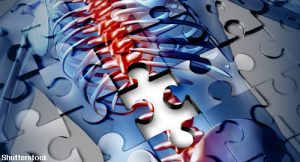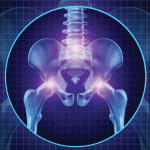 For one of the most prevalent chronic conditions and leading causes of disability in the U.S., a low-risk, low-cost treatment option may offer people relief from debilitating symptoms. A Michigan study found patients with chronic low back pain who self-administered acupressure had less pain and fatigue associated with their chronic pain.1
For one of the most prevalent chronic conditions and leading causes of disability in the U.S., a low-risk, low-cost treatment option may offer people relief from debilitating symptoms. A Michigan study found patients with chronic low back pain who self-administered acupressure had less pain and fatigue associated with their chronic pain.1
“We found people with chronic low back pain who performed one of two types of acupressure [i.e., stimulating or relaxing] for six weeks reported improved symptoms,” says study lead author Susan L. Murphy, ScD, OTR, associate professor, Department of Physical Medicine & Rehabilitation, University of Michigan, and research health science specialist at the VA Ann Arbor Health Care System, Geriatric Research Education and Clinical Center.
Acupressure involves using a finger, thumb or device to place pressure on specific points on the body to stimulate or relax energy centers associated with healing. Based on traditional Chinese medicine, the technique manipulates vital energy, called Qi, circulating through channels or meridians in the body. The idea is that an imbalance in these channels can cause disease or problems. Manipulating these channels with pressure (or needles in the case of acupuncture) at specific acupoints activates the energy pathways and removes obstructions that block energy flow, relieving pain by improving circulation and nutrition.2,3
Data show the benefits of acupressure for pain associated with cancer or osteoarthritis, but few data are available on the potential benefits for people with chronic low back pain.4,5 A systematic review and meta-analysis of the efficacy of using auricular acupressure for chronic low back pain (i.e., stimulating the external surface of the ear) found a significant effect in improving pain within 12 weeks of treatment, but with no significant effect on disability level.3
To narrow that gap, Dr. Murphy and colleagues conducted a randomized controlled pilot trial to assess the efficacy of acupressure to reduce two common symptoms experienced by people with chronic low back pain: fatigue and sleep problems.
The Study
According to Dr. Murphy, a main reason the team examined acupressure instead of acupuncture was because they were interested in interventions patients can do themselves. “Self-administered acupressure has little to no side effects and is very safe for people to try without healthcare provider monitoring,” she says.
The study included 67 patients with chronic low back pain, defined as nonspecific or low back pain persisting for at least three months, and having at least mild fatigue. All patients were 18 years or older and were on a stable medication regimen for two months prior to the study.
Of the 67 patients, 23 were randomized to receive standard care (i.e., whatever treatments they were already receiving for back pain and fatigue), 22 to relaxing acupressure (i.e., applying pressure to five acupoints for three minutes per point) and 22 to stimulating acupressure (i.e., applying pressure to six acupoints for three minutes per point). Trained acupressure educators taught patients in the acupressure groups how to self-administer the technique.
To assess the efficacy of acupressure, investigators compared the baseline scores of fatigue, pain and sleep quality of patients in all three groups to their scores after six weeks of treatment. The Brief Fatigue Inventory was used to measure fatigue, the Pittsburgh Sleep Quality Index to measure sleep quality, the Brief Pain Inventory to measure pain and the Roland Morris Scale to measure disability.
Findings
After controlling for age and sex, the study’s only significant finding was a significant reduction in fatigue in patients using stimulating acupressure compared with patients receiving standard care. Fatigue was reduced by 26% in these patients, decreasing from a mean 4.3 at baseline to 3.2 at six weeks.
When looking at pain scores, patients in both the relaxing and stimulating acupressure groups experienced reduced pain (35% and 36%, respectively) from baseline scores to scores at six weeks (4.3 to 2.9 for relaxing acupressure; and 4.5 to 2.9 for stimulating acupressure).
The study found no differences between the acupressure groups and usual care in sleep quality or disability.
Implications for Care
Seeing these as preliminary results for the potential benefit of acupressure for chronic low back pain, Dr. Murphy says she and her colleagues are planning to conduct a larger study.
“It’s important to determine if self-administered acupressure is effective in a larger group of people with chronic back pain and also to examine ways to best integrate effective and safe treatments, such as this, into clinical management,” she says.
Weiqing Ge, PT, DPT, PhD, professor of physical therapy, department of physical therapy, Youngstown State University, Youngstown, Ohio, who reported the efficacy of acupressure with physical therapy to reduce pain, increase function and decrease disability in a single system study of a patient with chronic low back, says the study by Murphy et al. confirms his research. The new study shows the efficacy of acupressure to reduce pain in patients with chronic low back pain with the additional information on its efficacy to reduce fatigue.2
“Acupressure is a low-cost, low-risk approach that has been used for self-management of pain,” he says.
Although more data are needed to confirm the efficacy of acupressure for chronic low back pain, the move toward using nonpharmacologic and alternative therapies for chronic low back pain is growing. In 2017, the American College of Physicians published an evidence-based clinical practice guideline on the use of noninvasive treatments for acute, subacute and chronic low back pain.6 This guideline follows a 2011 report by the Institute of Medicine calling for a transformation in how chronic pain is understood and treated, including an emphasis on promoting self-management of pain and tailoring pain care to each individual’s experience.7
Given the low risk and low cost of acupressure, and the growing emphasis on non-pharmaceutical approaches for chronic pain, more data on the benefits of acupressure for chronic low back pain are needed to strengthen the evidence on its potential.
Mary Beth Nierengarten is a freelance medical journalist based in Minneapolis.
References
- Murphy SL, Harris ER, Keshavarzi NR, et al. Self-administered acupressure for chronic low back pain: A randomized controlled pilot trial. Pain Med. 2019 Dec 1;20(12):2588–2597.
- Adams A, Eschman J, Ge W. Acupressure for chronic low back pain: A single system study. J Phys Ther Sci. 2017 Aug;29 (8):1416–1420.
- Yang LH, Duan PB, Hou QM, et al. Efficacy of auricular acupressure for chronic low back pain: A systematic review and meta-analysis of randomized controlled trials. Evid Based Complement Alternat Med. 2017;2017:6383649. Epub 2017 Jul 18.
- Zick S, Sen A, Wyatt, G, et al. Investigation of two types of self-administered acupressure for persistent cancer-related fatigue in breast cancer survivors: A randomized clinical trial. JAMA Oncology. 2016 Nov 1;2(11):1470–1476.
- Li LW, Harris RE, Tsodikov A, et al. Self-acupressure for older adults with symptomatic knee osteoarthritis: A randomized controlled trial. Arthritis Care Res (Hoboken). 2018 Feb;70(2):221–229.
- Qaseem A, Wilt TJ, McLean RM, et al. Noninvasive treatments for acute, subacute and chronic low back pain: A clinical practice guideline from the American College of Physicians. Ann Intern Med. 2017 Apr 4;166(7):514–530.
- Institute of Medicine (U.S.) Committee on Advancing Pain Research, Care and Education. Relieving pain in America: A blueprint for transforming prevention, care, education and research. Washington, D.C.: National Academies Press (US); 2011.


